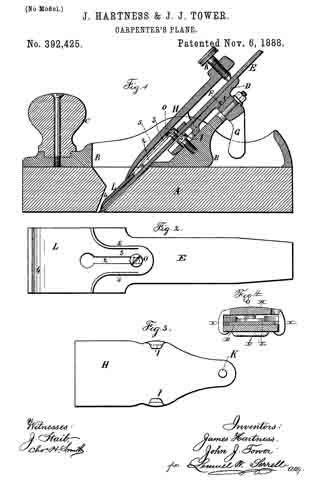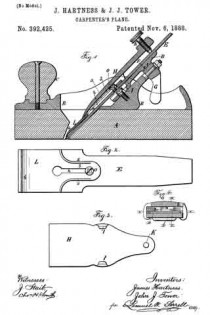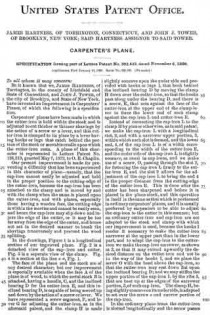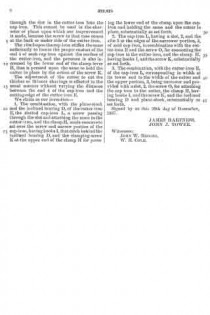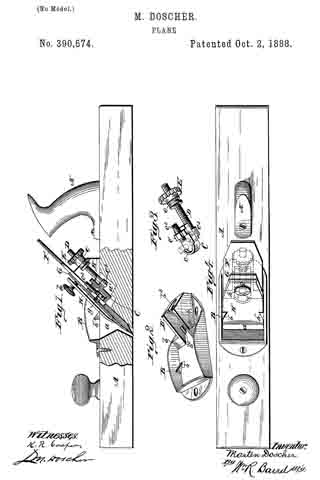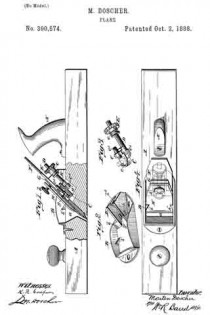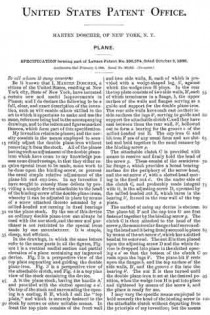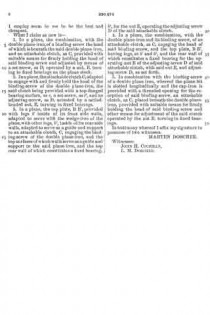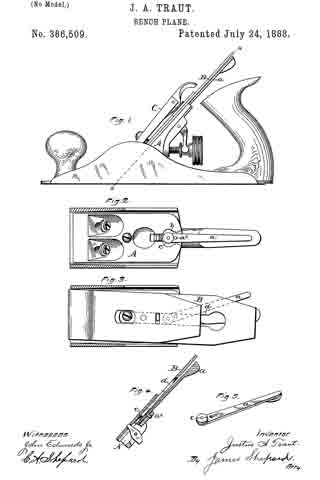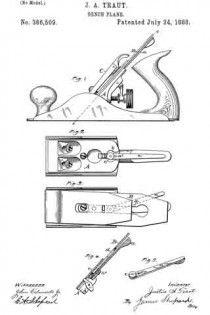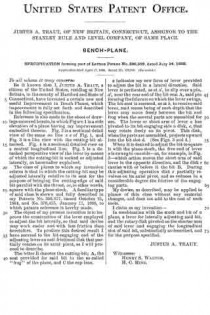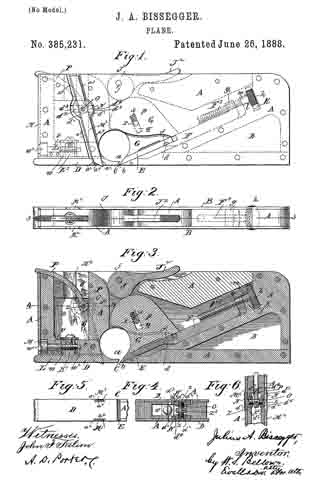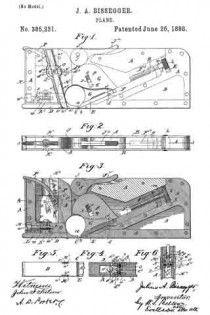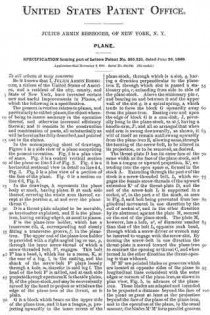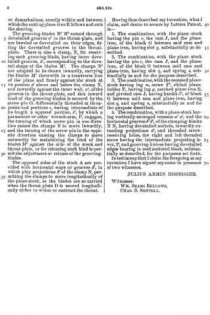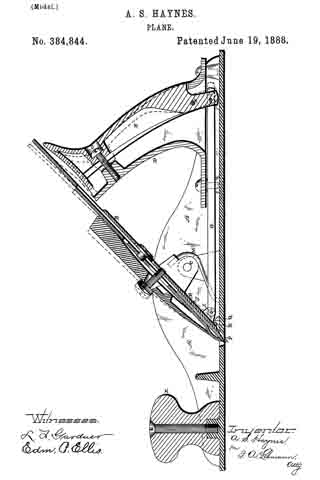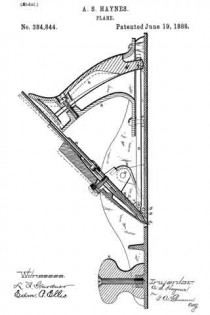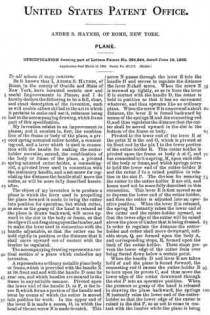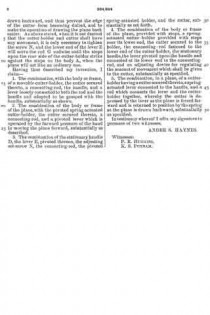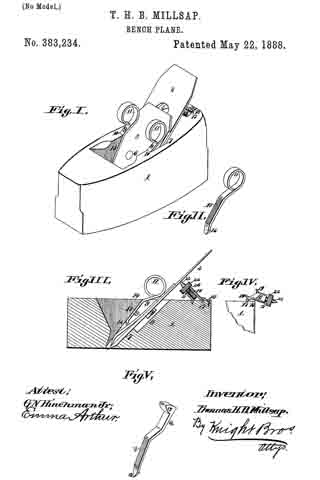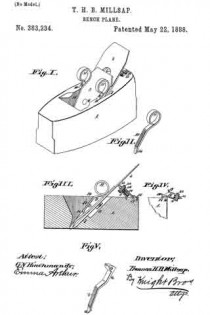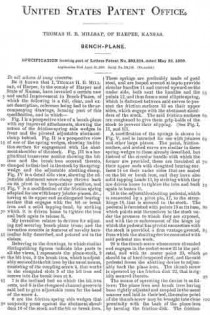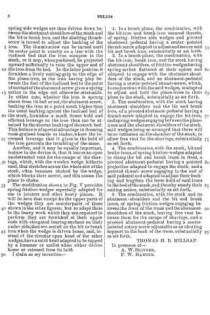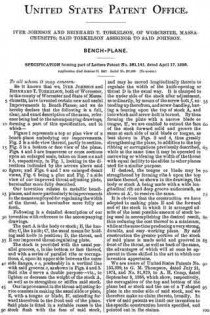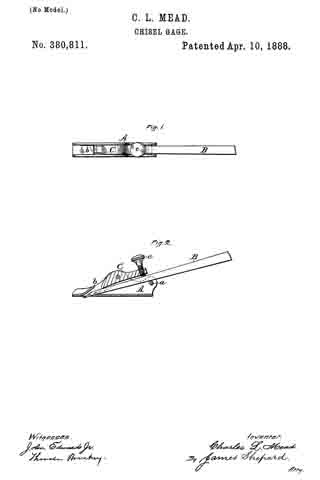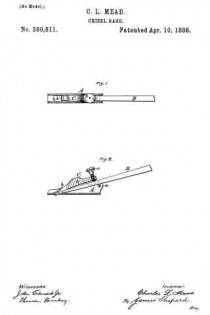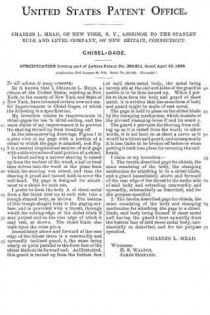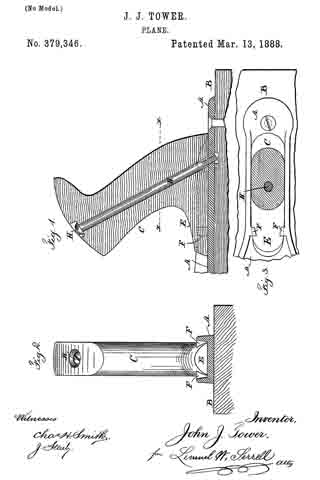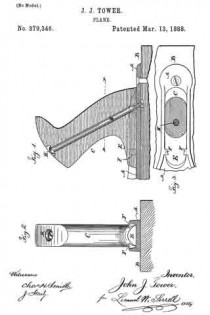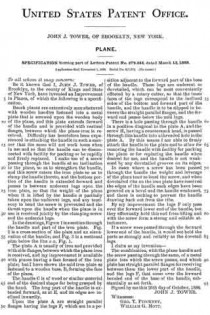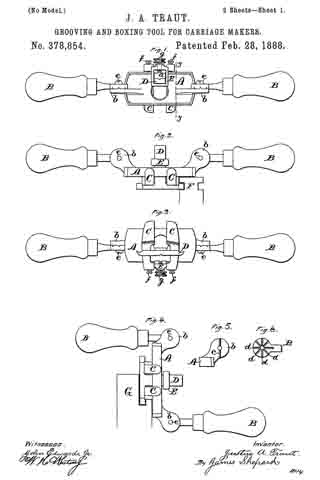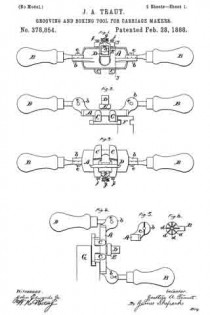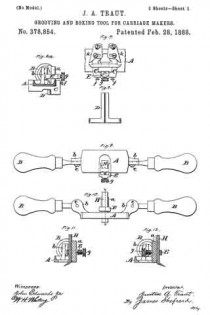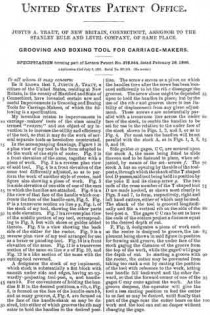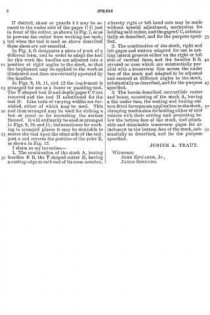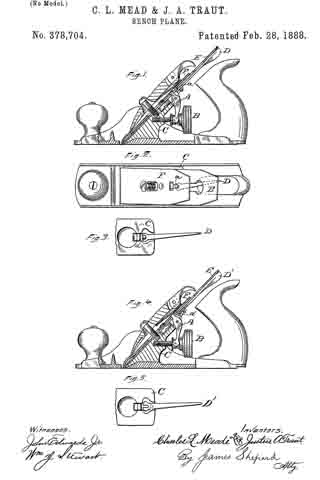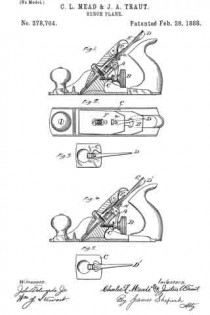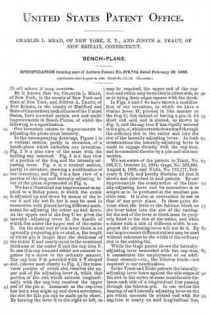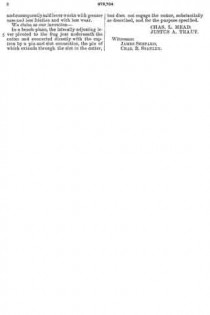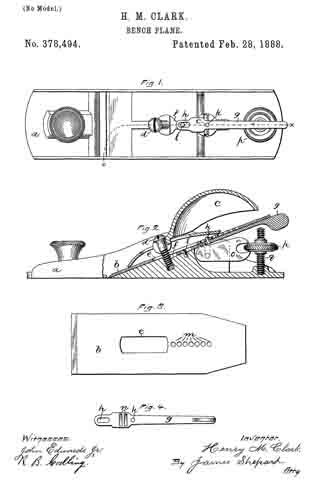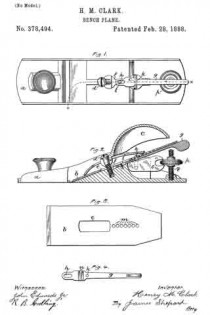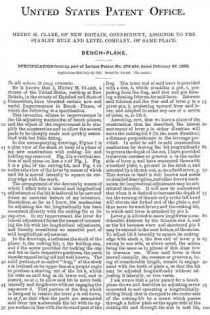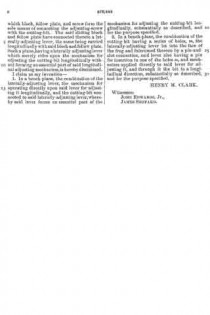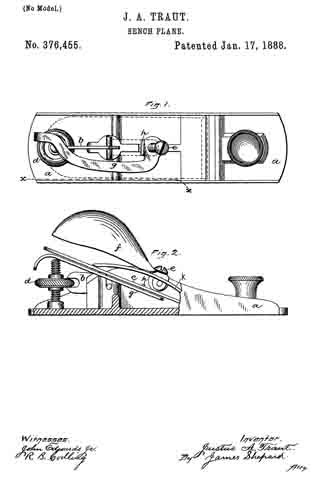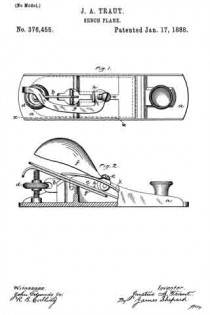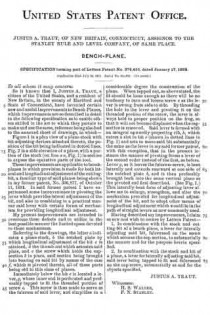No. 394,411 – Bench-Plane (William Stevenson) (1888)

UNITED STATES PATENT OFFICE.
_________________
WILLIAM STEVENSON, OF DOUGLAS FLAT, ASSIGNOR OF
ONE-HALF TO JOHN MONTEVERDA, OF STOCKTON, CALIFORNIA.
BENCH-PLANE.
_________________
SPECIFICATION forming part of Letters Patent No. 394,411, dated December 11, 1888.
Application filed April 18, 1888. Serial No. 271,087. (No model.)
_________________
To all whom it may concern:
Be it known that I, WILLIAM STEVENSON, of Douglas Flat, Calaveras county, State of California, have invented an Improvement in Combination-Planes; and I hereby declare the following to be a full, clear, and exact description of the same.
My invention relates to the class of planes in which blades of different character are combined in the same stock; and my invention consists in the novel stock, the double-ended blades and their manner of arrangement, and means for adjusting them in the stock, as I shall hereinafter more fully describe.
The object of my invention is to provide a plane of simple construction, and which, by reason of its different blades, is adapted for several uses.
Referring to the accompanying drawings for a more complete explanation of my invention, Figure 1 is a perspective view of my combination-plane. Fig. 2 is a top view of same. Fig. 3 is a side elevation of the stock, the securing-plate d being removed to show the blade and its operative mechanism.
A is the stock of the plane, having its upper and lower edges made with central longitudinal guides, a, thus dividing it into four working-surfaces, one being on each side of the central guide of each edge. These surfaces in any given stock may be made in the proper shape or contour to suit the several uses intended for that particular combination-tool. In the present instance, in order to illustrate this fully, I have shown two of the surfaces — one on each edge and on the same side of the guides a — as “matching” surfaces — that is, one is for a “tongue” and the other is for a “groove.” The remaining two surfaces I show as a simple “nosing” surface and a “molding” surface. I do not confine myself to them, however, for my invention contemplates the making of any suitable surfaces, the essential feature of the stock in this respect being its construction, providing for any four working-surfaces.
In each side of the stock are made two throat-sockets, B, which are arranged in reversed position with relation to each other, and also in each side of the stock is made a groove-seat, C, opening at each end into one of the working-surfaces and near each end into a throat-socket. Into these grooves C are fitted the blade-guides D, which are secured in place by plates d, let in flush with the sides of the stock and secured thereto by screws d’. Fitted in one side of each of these blade-guides is a rotary pin, e, which carries a pinion, E, the teeth of which project into the guide far enough to engage the rack-teeth of the blades, as I shall presently explain.
Upon the outer end of each pin e (which projects through the securing-plate d) is fixed a lever-arm, F, having at one end a small thumb-piece, f, by which it may readily be turned to turn the pin axially and rotate the pinion, and in the other end said lever-arm carries a set-screw, f’, the lower end of which is made to come in contact with the plate d, whereby the arm may be firmly set in the position to which it may be turned, thus holding the pinion rigidly.
G are the bits. I have shown two. Each is a double-ender-that is to say, a cutting-edge is made on each end. I do not confine myself to the particular shape or character shown on these planes, for they are made to adapt them to the uses intended and corresponding to the working-surfaces of the particular stock they are designed to fit. In this case I have shown a matching-edge on each end of one of the bits, and on the other I have shawn a nosing-edge on one end and a molding-edge on the other end. There are therefore four edges in the set. Each of these bits is formed or provided with rack-teeth g. These bits are fitted through the guides D, so that their rack-teeth are engaged by the pinion E, and their edges extend through the ends of the groove-seats C into proper position along the working-surfaces of the stock. They are made of such a length that when the edge on one end is projected for proper operation in connection with its working-surface the edge on the other end is withdrawn from its working-surface, so as not to be in the way when handling the tool.
The operation is as follows: When I wish to use the grooving-edge, I turn the lever-arm F by the thumb-piece f in a direction and to an extent sufficient to cause the pinion E to project said edge to working position, (the edge on the other end being withdrawn out of the way by the same movement,) and I then fix it in position by setting the screw f’. The operation is the same with any of the other edges.
Having thus described my invention, what I claim as new, and desire to secure by Letters Patent, is —
1. In a combination-plane, a bit having a cutting-edge on each end and having rack-teeth formed on one of its sides, substantially as herein described.
2. In a combination-plane, a stock having a working-surface on its upper and lower edges, in combination with a bit fitted to the stock and having a cutting-edge on each end, and an adjusting device for operating the bit, so that when its cutting-edge on one end is projected into position along its corresponding working-surface the cutting-edge on its other end is withdrawn from its working-surface, substantially as herein described.
3. In a combination-plane, a stock having a working-surface on its upper and lower edges, in combination with a bit fitted to the stock and having a cutting-edge on each end and rack-teeth on its side, and the mechanism for adjusting the bit, as described, consisting of a rotary pin and a pinion carried thereby and engaging the rack-teeth of the bit, substantially as herein described.
4. In a combination-plane, a stock having a working-surface on its upper and lower edges, in combination with a bit fitted to the stock and having a cutting-edge on each end and rack-teeth on its side, and the mechanism for adjusting the bit, as described, and holding it when adjusted, consisting of the rotary pin, the pinion on the pin engaging the rack-teeth of the bit, the lever-arm on the pin, and the set-screw in the lever-arm, substantially as herein described.
5. In a combination-plane, a stock having a working-surface on its upper and lower edges, the bit-guide let into the side of the stock, and the plate screwed to the stock for holding the guide, in combination with a bit fitted in the guide and having a cutting-edge on each end and rack-teeth on its side, and the mechanism tor adjusting the bit, as described, and holding it when adjusted, consisting of the rotary pin in the side of the guide, the pinion on the pin engaging the rack-teeth of the bit, the lever-arm on the outer end of the pin, and the set-screw in the lever-arm, substantially as herein described.
In witness whereof I have hereunto set my hand.
WVILLIAM STEVENSON.
Witnesses:
JOHN W. BATTEN,
ENOS F. FLOYD.




